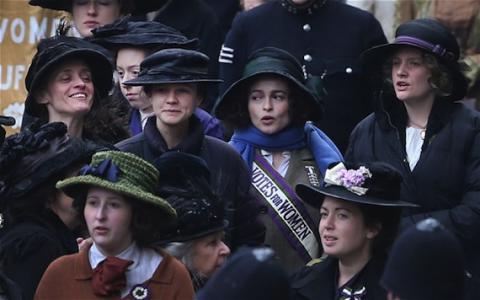I really didn’t want to write this review. I still don’t. Not because Meryl Streep is a lie (she appears for like 15 seconds). Not because the main character never existed in this supposedly historical film (the director calls it a “composite character”). Not because Suffragette is a bad film—it’s not. It’s fine. It’s Oscar bait. Whatever.
I didn’t want to write this review because I’m tired of writing about white people. I’m tired of fantasy worlds where people of color don’t exist. Where even the made up—excuse me—composite characters are white. It gets really disheartening to see yourself written out of popular culture, written out of history time and time again. It’s really hard to keep answering my son’s question: “How come there aren’t any brown people in this?”
When I met with the director of Suffragette, Sarah Gavron, she was quick to address the lack of women of color in the movie. “In America, you had a very different ethnic makeup,” she explained. “In Britain, you had immigrants, but you didn’t really have women of color at that stage—apart from two very prominent women. Later in the movement, you got the diversity that reflects the wonderful diversity we have in Britain today. But you did have a range of classes.”
At first I let this go, but it was nagging at me. This thought in the back of my head that it wasn’t right. As a person of color, I’ve heard time and time again similar excuses for why people of color have not been represented, especially in history. But the truth is, we are not a recent invention. One of the “two prominent women” that Gavron was likely referring to was Sophia Duleep Singh, an Indian princess who helped mobilize many Indian women in Britain in the suffrage movement. There’s photographic evidence that there were far more than two women of color in the suffrage movement. But the written record is primarily white.
A week or so after my interview with Gavron, the stars of Suffragette showed up in a Time Out magazine spread wearing shirts saying “I’d rather be a rebel than a slave.” This was a quote from Emmeline Pankhurst, the prominent suffragette portrayed by Meryl Streep. These pictures of white women wearing a shirt that implied that slavery is a choice offended many people, including me. Many white people, including the staff at Time Out, came to their defense, explaining that the quote was from Pankhurst and had nothing to do with American slavery—it was Britain after all. But slavery had existed in Britain as well. And there is evidence from other statements by Pankhurst that she was comparing lack of suffrage to the slavery of black people. But regardless of the context of the original statement, what would make anybody think that the quote would be appropriate today?
I thought about my interview with Gavron, on how many times she had said that she had wanted this movie to be accessible, and that is why she made the decision to create a “composite character” for the lead. Someone who everyone could relate to.
But who is this “everyone”? Because not only are the known prominent suffragettes of color left out of the movie, there are no people of color in this movie. Not in the streets, not in the factories, not in the crowds. Nowhere. They don’t exist. The creators of this film took creative license to generate a whole new main character for the film, but they couldn’t come up with a single brown face in a crowd?
But the same process that thinks an entire film in which people of color don’t exist is “relatable” is the same process that leads a group of white women to wear shirts exclaiming their brave preference to not be slaves. This isn’t new, it happens all of the time in our books and our television shows and our movies. It’s in the heroes we celebrate, the struggles we memorialize, and the lectures we get from our teachers.
And I’m not here for it. Not anymore.
So I’m not going to write a review about Suffragette, because I’m no longer going to legitimize films that refuse to acknowledge the existence of people of color. And neither should you.
[Ijeoma Oluo is a Seattle-based writer. Her work primarily focuses on issues of race, feminism, the arts, and personal essay.]


Spread the word